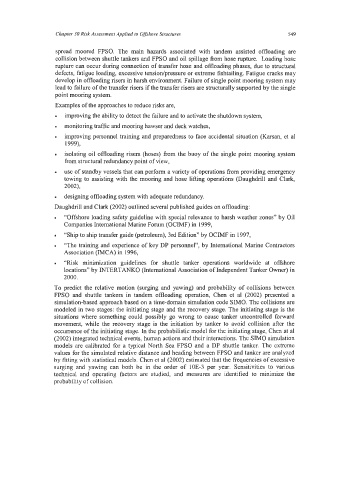Page 573 - Marine Structural Design
P. 573
Chapter 30 Risk Assessment Applied to Offshore Structures 549
spread moored FPSO. The main hazards associated with tandem assisted offloading are
collision between shuttle tankers and FPSO and oil spillage from hose rupture. Loading hose
rupture can occur during connection of transfer hose and oflloading phases, due to structural
defects, fatigue loading, excessive tensiodpressure or extreme fishtailing. Fatigue cracks may
develop in offloading risers in harsh environment. Failure of single point mooring system may
lead to failure of the transfer risers if the transfer risers are structurally supported by the single
point mooring system.
Examples of the approaches to reduce risks are,
improving the ability to detect the failure and to activate the shutdown system,
monitoring traffic and mooring hawser and deck watches,
improving personnel training and preparedness to face accidental situation (Karsan, et al
1999),
isolating oil offloading risers (hoses) from the buoy of the single point mooring system
from structural redundancy point of view,
use of standby vessels that can perform a variety of operations from providing emergency
towing to assisting with the mooring and hose lifting operations (Daughdrill and Clark,
2002),
designing offloading system with adequate redundancy.
Daughdrill and Clark (2002) outlined several published guides on offloading:
“Offshore loading safety guideline with special relevance to harsh weather zones” by Oil
Companies International Marine Forum (OClMF) in 1999,
“Ship to ship transfer guide (petroleum), 3rd Edition” by OCIMF in 1997,
“The training and experience of key DP personnel”, by International Marine Contractors
Association (IMCA) in 1996,
“Risk minimization guidelines for shuttle tanker operations worldwide at offshore
locations” by INTERTANKO (International Association of Independent Tanker Owner) in
2000.
To predict the relative motion (surging and yawing) and probability of collisions between
FPSO and shuttle tankers in tandem offloading operation, Chen et al (2002) presented a
simulation-based approach based on a time-domain simulation code SIMO. The collisions are
modeled in two stages: the initiating stage and the recovery stage. The initiating stage is the
situations where something could possibly go wrong to cause tanker uncontrolled forward
movement, while the recovery stage is the initiation by tanker to avoid collision after the
occurrence of the initiating stage. In the probabilistic model for the initiating stage, Chen at al
(2002) integrated technical events, human actions and their interactions. The SIMO simulation
models are calibrated for a typical North Sea FPSO and a DP shuttle tanker. The extreme
values for the simulated relative distance and heading between FPSO and tanker are analyzed
by fitting with statistical models. Chen et a1 (2002) estimated that the frequencies of excessive
surging and yawing can both be in the order of 10E-3 per year. Sensitivities to various
technical and operating factors are studied, and measures are identified to minimize the
probability of collision.

